+Search query
-Structure paper
| Title | Structural basis for energy harvesting and dissipation in a diatom PSII-FCPII supercomplex. |
|---|---|
| Journal, issue, pages | Nat Plants, Vol. 5, Issue 8, Page 890-901, Year 2019 |
| Publish date | Jul 29, 2019 |
 Authors Authors | Ryo Nagao / Koji Kato / Takehiro Suzuki / Kentaro Ifuku / Ikuo Uchiyama / Yasuhiro Kashino / Naoshi Dohmae / Seiji Akimoto / Jian-Ren Shen / Naoyuki Miyazaki / Fusamichi Akita /  |
| PubMed Abstract | Light-harvesting antenna systems in photosynthetic organisms harvest solar energy and transfer it to the photosynthetic reaction centres to initiate charge-separation and electron-transfer reactions. ...Light-harvesting antenna systems in photosynthetic organisms harvest solar energy and transfer it to the photosynthetic reaction centres to initiate charge-separation and electron-transfer reactions. Diatoms are one of the important groups of oxyphototrophs and possess fucoxanthin chlorophyll a/c-binding proteins (FCPs) as light harvesters. The organization and association pattern of FCP with the photosystem II (PSII) core are unknown. Here we solved the structure of PSII-FCPII supercomplexes isolated from a diatom, Chaetoceros gracilis, by single-particle cryoelectron microscopy. The PSII-FCPII forms a homodimer. In each monomer, two FCP homotetramers and three FCP monomers are associated with one PSII core. The structure reveals a highly complicated protein-pigment network that is different from the green-type light-harvesting apparatus. Comparing these two systems allows the identification of energy transfer and quenching pathways. These findings provide structural insights into not only excitation-energy transfer mechanisms in the diatom PSII-FCPII, but also changes of light harvesters between the red- and green-lineage oxyphototrophs during evolution. |
 External links External links |  Nat Plants / Nat Plants /  PubMed:31358960 PubMed:31358960 |
| Methods | EM (single particle) |
| Resolution | 3.3 - 3.8 Å |
| Structure data | EMDB-9775, PDB-6j3y: |
| Chemicals |  ChemComp-FE2:  ChemComp-CLA:  ChemComp-PHO:  ChemComp-BCR:  ChemComp-SQD: 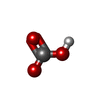 ChemComp-BCT:  ChemComp-LHG:  ChemComp-LMG: 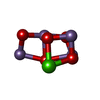 ChemComp-OEX:  ChemComp-DGD: 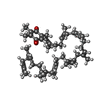 ChemComp-PL9:  ChemComp-HEM: 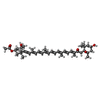 ChemComp-A86: 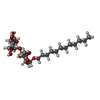 ChemComp-LMU: |
| Source |
|
 Keywords Keywords | ELECTRON TRANSPORT / Photosystem |
 Movie
Movie Controller
Controller Structure viewers
Structure viewers About Yorodumi Papers
About Yorodumi Papers









 chaetoceros gracilis (Diatom)
chaetoceros gracilis (Diatom)